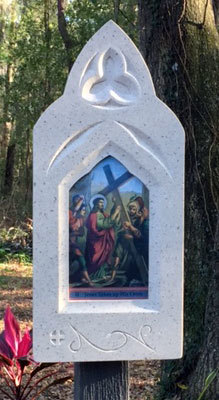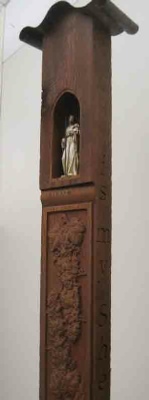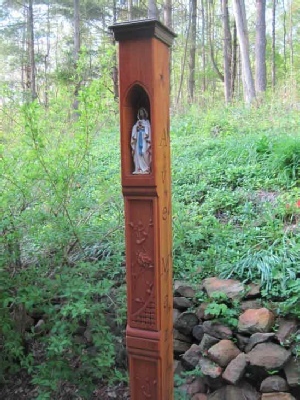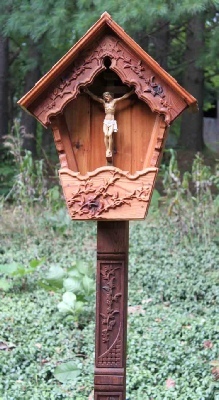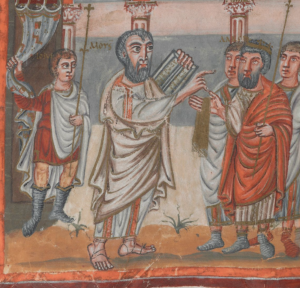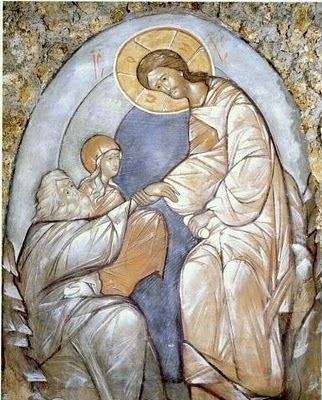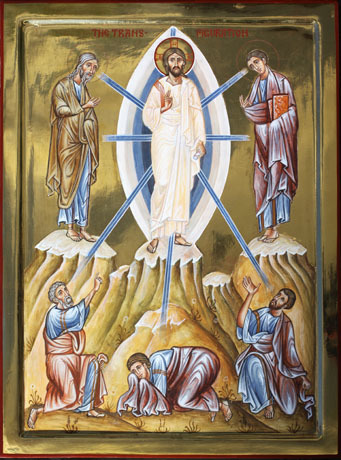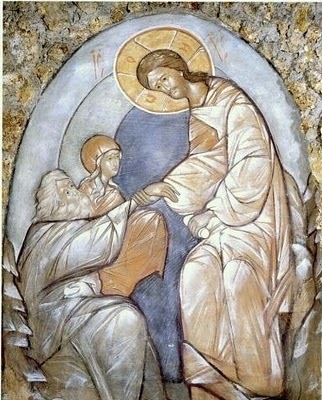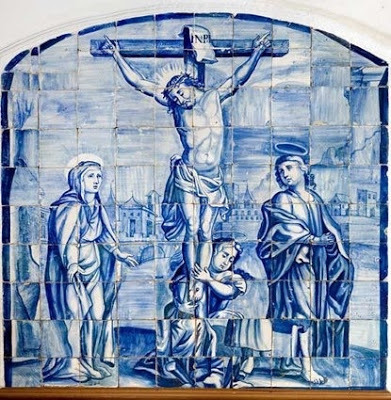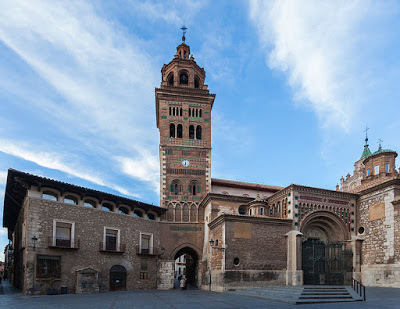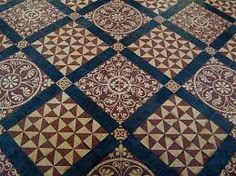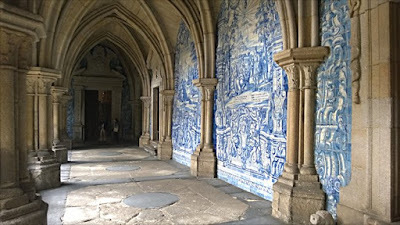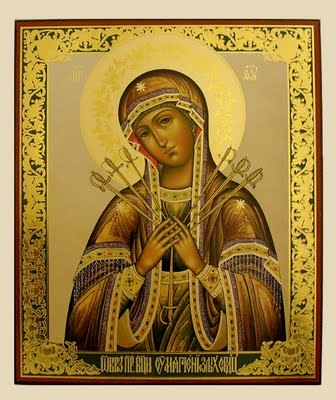David Clayton's Blog, page 2
March 8, 2018
Art, Artists, and a Theology of Beauty – part II
 “Ultimately our true vocation and final destiny is to praise God in His Truth, Beauty and Goodness.”
“Ultimately our true vocation and final destiny is to praise God in His Truth, Beauty and Goodness.”Beauty from Emptiness
A beautiful spirit may shine even through a form that has been weakened. Drawing on both old and new testaments the early church fathers developed the doctrine of “kenosis” from a Greek word meaning emptiness. In the context of a theology of beauty kenosis refers to a humiliation of form, an emptying of one’s self, so that the divine beauty shines more brightly. In the Old Testament this theme is taken up in the suffering servant.
“You are the fairest of the sons of men; grace is poured upon your lips; therefore God has blessed you for ever.” (Psalms 45:2)
“For he grew up before him like a young plant, and like a root out of dry ground; he had no form or comeliness that we should look at him, and no beauty that we should desire him.” (Isaiah 53:2)
In Christian thought this “kenotic veil” is the virtue of humility. Humility dims the beauty of the form and is a guard against the temptation of vanity.
“So you also outwardly appear righteous to men, but within you are full of hypocrisy and iniquity.” (Matthew 23:28)
“Let not yours be the outward adorning with braiding of hair, decoration of gold, and wearing of fine clothing, but let it be the hidden person of the heart with the imperishable jewel of a gentle and quiet spirit, which in God’s sight is very precious.” (1Peter 3:3-4)
The so-called “Fools for Christ” took this idea to the extreme. These were individuals who denied themselves everything, including personal dignity, so that Christ may shine more radiantly through them. In such cases the ugliness of the infirmity becomes transfigured to serve the spirit within and becomes an icon of suffering and as such beautiful to behold.
By contrast there is ugliness without spirit, a perversion of natural being that borders on the demonic. Form without content, a hollow shell, it is the antithesis of being. When it manifests itself as art it shows us a world without God. Manifested in our perception of the created world, it offers us a glimpse of Hell, the negation of all that is good and beautiful and true.
An Act of Praise
Recognizing this inner beauty, this divine spark, within all things and drawing it out for others to see is the vocation of the artist. This is an act of Praise. Created in the image of the Creator, man is sub-creator, artist and poet. His ultimate destiny is to praise God. Through all the covenants described in scripture, this thread is consistent. When God creates the world He is in effect creating a temple. In that temple He places man to cultivate the temple, renew it, and transform it into an offering to God.
“And God blessed them, and God said to them, ‘Be fruitful and multiply, and fill the earth and subdue it; and have dominion over the fish of the sea and over the birds of the air and over every living thing that moves upon the earth.’” (Genesis 1:28)
Throughout all of scripture we see that our ultimate destiny is to sing the praises of God, and that praise is intimately linked with His beauty.
“Ascribe to the Lord the glory due His name; bring an offering, and come before Him! Worship the Lord in Holy Array;” (1Chronicles 16:29) Holy Array is frequently translated as “beauty of holiness.”
“…and when he had taken counsel with the people, he appointed those who were to sing to the Lord and praise Him in Holy Array, as they went before the army, and say, ‘Give thanks to the Lord, for His steadfast love endures forever.’” (2Chronicles 20:21)
“Ascribe to the Lord the glory of His name; worship the Lord in Holy Array.” (Psalms 29:2)
“Worship the Lord in Holy Array; tremble before Him, all the earth!” (Psalms 96:9)
“Which is the guarantee of our inheritance until we acquire possession of it, to the praise of His glory,” (Ephesians 1:14)
“Worthy is the lamb who was slain, to receive power and wealth and wisdom and might and honor and glory and blessing,” (Revelation 5:12)
“And all the angels stood round the throne and round the elders and the four living creatures, and they fell on their faces before the throne and worshipped God,” (Revelation 7:11)
“And the twenty four elders and the four living creatures fell down and worshipped God who is seated on the throne, saying. ‘Amen. Hallelujah.’” (Revelation 19:4)
A Theology of Beauty
God is perfect beauty and all that He creates is beautiful. By rejecting God our first parents rejected beauty, but through the workings of the Holy Spirit, God calls to us through our natural attraction to all that is beautiful. Ultimately our true vocation and final destiny is to praise God in His Truth, Beauty and Goodness.
Beauty then is the unique vocation of the artist. His talent has been given him to explore this vocation. His work reflects the splendor of God, brings hope and joy to His people, and lifts hearts and minds to His divine beauty. Through artistic ability, and with the help of the Holy Spirit, the artist is called upon to unite the primal beauty of creation with the divine beauty of God. Like everyone else his ultimate destiny is to forever sing the praises of God.
And there will be obstacles. The world may attack the work of the artist and belittle his efforts. It may praise the ugly and shallow over the beautiful and sacred. But this is the artist’s battle as well. It is a battle Saint Paul prepared us for.
“For we are not contending against flesh and blood, but against the principalities, against the powers, against the world rulers of this present darkness, against the spiritual hosts of wickedness in the heavenly places.” (Ephesians 6:12)
this article originally appeared at www.DeaconLawrence.org
______________________________________
Pontifex University is an online university offering a Master’s Degree in Sacred Arts. For more information visit the website at www.pontifex.university
Lawrence Klimecki is a deacon in the Diocese of Sacramento. He is a public speaker, writer, and artist, reflecting on the intersection of art and faith and the spiritual “hero’s journey” that is part of every person’s life. He maintains a blog at www.DeaconLawrence.org
March 7, 2018
Have Faith! Leonardo, Raphael, Michelangelo and You! Be a Modern Master or Enlightened Patron
The Master 0f Sacred Arts program at www.Pontifex.University offers a formation in beauty for artists, patrons of the arts and anyone who wants to contribute creatively to the transformation of the culture. It is a chance to travel on the Way of Beauty in a way never before available. Our goal is to form the artists who will stand alongside any of the greats of the past, and who will transform the 21st century into a golden age that the will be viewed as important of any of the great cultural movements of past.
This is a range of classes that are rooted in the Catholic intellectual tradition as well as practical classes in painting, sculpture and sacred geometry (as part of the Mathematics of Beauty course). While the focus is on visual arts and architecture, this is a Catholic inculturation and formation that will help artists in any discipline (including, for example, literature and music). There are electives that allow for specialization in potentially any of these other creative fields.
It also provides also a theory of Christian culture that will enable any person to consider how their everyday activities can be informed by the pattern of Christ and so contribute to the evangelization of the culture through what is called the New Evangelization.
Every course is unique to the Master of Sacred Arts. You can take the whole program or individual courses; audit or for credit to compliment what you already know or feel you can teach yourself.
Here is a list of courses, for more details see www.Pontifex.University:
You need 30 credits minimum to obtain the MSA degree:
The mandatory subjects are as follows (21 credits):
A History and Practical Theology of Images (including the theory of the Way of Beauty and Christian culture) 3 credits
The New Testament in Words and Images 3 credits
The Old Testament in Words and Images 3 credits
The Bible and the Liturgy 3 credits
The Mathematics of Beauty (harmony and proportion) 2 credits
Fundamentals of Beauty in Architecture 1 credits
A Survey of Philosophy of the Good, the True, and the Beautiful 3 credits
The Philosophy of Nature and of Man 3 credits
Electives – you will require a minimum of 9 credits from any combination of the list below,
which must include 6 ‘Studio’ credits or a written thesis:
Studio: A Study of Artistic Methods for Patrons and Artists 3 credits
Studio: An Introduction to Sculpture 3 credits
Studio: (Approved workshops by arrangement eg Hexaemeron.org; St Cecilia Academy, Archdiocese of NY) 3-6 credits
or
Thesis: 10,000-words, subject student choice approved by the Provost. 6 credits
The Words of the Mass 1 credit
The Psalms in Words, Images and Prayer 3 credits
Sacred Music 1 credit
Christian Humanism in the Modern Cinema 1 credit
March 5, 2018
An Online Source for Ceramic Images and Hand-Carved Shrines
Following on from recent articles encouraging people to think about creating ceramic icon corners that can be beautiful and discreet, yet clearly visible signs of faith, here, and here, here is someone who can create such images and also carve beautiful shrines in wood or stone to house them in. It is Jerome Quigley of www.waysideshrines.org.
I met him at an Art and Faith event at St Pius X Catholic Church in Rock Island, Illinois this past week. He explained to me that he creates the carvings himself in wood or an artificial granite (used for heavy kitchen surfaces and which can be carved like wood). He can respond to commission and even more interestingly, he has a process whereby he can set images into porcelain. This is not a print, but rather one in which the pigment is set directly into the chemical structure of the substrate porcelain – similar to the way in which pigment is incorporated into the plaster in frescoes.
The tradition of reproducing paintings on porcelain goes back to the 19th century at least. I have recently seen several handpainted porcelain copies of the highest quality made in that time. The look of these hand-painted antique reproductions is the same those that Jerome makes. Here is a 19th-century example. Porcelain has a luminosity to it that you can see in this photograph.
I spoke to him about the possibility of creating icon corners consisting of three images and he was confident that he could produce something beautiful, either on a shrine or as a ceramic piece that could be set in a building by the purchaser, for example. It would need demand from customers for this to happen, but if the business logic is there for Jerome to do it, I am happy to work with him to help create outdoor icon corners.
Here are some more examples of his work. Once again his website is www.waysideshrines.org.
Here
March 4, 2018
Natural Law and the 10 commandments. A Meditation for the 3rd Sunday of Lent. From a Priest of the I.V.E.
In those days, God delivered the commandments: 1 Ex 20:1-17.
Here is another Lenten reflection from a priest from the Institute of the Incarnate Word, IVE, which is for the week of the 3rd Sunday of Lent. This is by Fr Nicholas Grace who is in Cowdenbeath, Scotland.
“I, the LORD, am your God, who brought you out of the land of Egypt, that place of slavery…I am a jealous God, inflicting punishment for wickedness but mercy…on those who love me and keep my commandments.”
Considering this text, I would like, in this article, to focus on two things in a very brief manner.
First: The Natural Law, written by God on every human heart.
Second: What are the Ten Commandments & Why they are so important.
The Natural Law, written by God on every human heart: Every member of Nature, every plant, every animal has a law which makes them tend to their goal, which makes them work.
Every human being has a law and must remain faithful to it if they are going to reach their goal if they are going to function correctly. This is called man’s Natural law.
Why is it called natural? This Law is rooted in a set of natural inclinations to specific goods. Natural inclinations toward Self-preservation, toward having and raising children, toward knowing the truth about God and living in society. It is imprinted in our hearts. It doesn’t have to be taught or learned. Like our DNA or genetic code, we also have this moral code weaved into our very being.
How does it function? -This law, through our intelligence, tells us what is right for us, what is wrong for us, what is good for us & what is bad for us. When our actions conform to this law they help us fulfill our purpose in life & are thereby right & morally good. Similarly, when our actions are at variance with this law, they deter us from that purpose and are therefore wrong & immoral. Some examples: The law of our Nature tells us that…
● Nourishing our bodies is right, but overindulging to the detriment of health is wrong.
● Self-preservation is right, but selfishness is wrong.
● To love another person is good, but to love someone already seriously
committed to another is not.
Now while it is easy to recognize that this knowledge comes naturally to us, we must also admit, very often, that same knowledge is rejected. In fact, the modern Western World is in a moral crisis. Institutions and governments often deny the Existence of the Natural law inscribed in every human heart. This denial has assisted in the spread of a morality not based on human nature but based on an easily manipulated social consensus.
Is there a consequence? This denial means that all moral opinions become valid.
Why is that a problem? Values become distorted. Take tolerance, it has been distorted to promote a society where no one’s choices are criticised because criticism might make someone feel bad.
Why is that a problem? Isn’t it best to make people feel nice? People’s feelings are easily manipulated and once manipulated evil can be called good & good can be called evil, evil vices can be presented as virtues and virtues as vices to the point where feelings totally outrank reason.
Is there a solution? We already have it!. God in his Wisdom and as a convenience, explicitly revealed the Ten Commandments, which very clearly express all those Laws already written in the heart of man, but often conveniently ignored because of the stubbornness and selfishness of man.
What are the Ten Commandments & Why are they so important?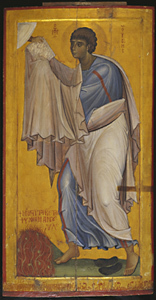 As an exercise say and name aloud each of the Ten Commandments.
As an exercise say and name aloud each of the Ten Commandments.
Then consider: If everyone in the world kept even half of them would the quality of life on our planet improve? Would human beings be working so much better?
The answer is, of course, YES, because the Commandments aren’t just Religious guidelines, they are also God’s design for work, for families, for friendships and for society as a whole.
A: We can compare the Ten Commandments to the handbook for a car. A car is a complicated piece of machinery, and the maker’s handbook tells you how to take care of our car properly so that you can get the most out of it. The Ten Commandments are God’s handbook for human beings.
Why else are they so important?
Many people no longer respect God’s authority. As a result, they no longer respect authority of any kind, whether politicians, parents, Priests, teachers or employers and the secular, as well as, the Religious community suffer greatly because of this lack of respect.
We live in an age of Moral Relativism: All Morality is relative. All truth is relative. Unfortunately, the more everyone makes up his or her own truths, the less truth there will be. The Ten Commandments preserve for us the ten most important truths.
There is tremendous ignorance about God. The Commandments remind the world of his existence, manifest his plan and express his personality.
Finally, The Commandments are extremely important, but they are not everything. For this reason, I would like to conclude this article with a story which might illustrate my point. It is a missionary story which concerns the Taliabo people of Indonesia.
“Many years ago, two families from New Tribes Mission, moved in with the Taliabo to live with them and learn their language. They began teaching the Scriptures, working their way forward to Christ and the Gospel. However, soon after the missionaries taught the people the Ten Commandments, a group of men visited them at their hut.
We are in big trouble with God. God’s law tells us not to kill, but we have killed other men. God’s law tells us not to steal, but we have stolen. We have broken God’s commandments, but we did not know that God commanded these things. From now on, we will keep God’s Commandments.
A couple of weeks later they returned to the missionaries’ hut. We are in really big trouble with God. Now we know God’s Commandments, but we still break them”.
I wanted the story to underline to those reading this article that, although God has written his law in our hearts we cannot keep it. Even though God has revealed his law through his prophets, we cannot keep it. The Taliabo people, just like the people of Israel, broke almost every Commandment immediately after receiving them.
The point is that Knowledge of the law is not enough. Knowing what is right does not confer power to do what is right, as Socrates incorrectly supposed. That is why, we have doctors who smoke, financial advisors who are in debt, and marriage counselors who are divorced!
The Ten Commandments do not remedy our sins; rather they reveal them and underline our need for a Saviour who can forgive them. That Saviour is Jesus Christ.
This Lent let us make a great effort to, not only, live by following the Ten Commandments but also seek Jesus Christ in the Sacrament of Reconciliation, when we will probably fail in our best efforts to keep the Commandments.
1,160 words
Natural Law and the 10 commandments. A Meditation the 3rd Sunday of Lent. From a Priest of the I.V.E.
In those days, God delivered the commandments: 1 Ex 20:1-17.
Here is another Lenten reflection from a priest from the Institute of the Incarnate Word, IVE, which is for the week of the 3rd Sunday of Lent. This is by Fr Nicholas Grace who is in Cowdenbeath, Scotland.
“I, the LORD, am your God, who brought you out of the land of Egypt, that place of slavery…I am a jealous God, inflicting punishment for wickedness but mercy…on those who love me and keep my commandments.”
Considering this text, I would like, in this article, to focus on two things in a very brief manner.
First: The Natural Law, written by God on every human heart.
Second: What are the Ten Commandments & Why they are so important.
The Natural Law, written by God on every human heart: Every member of Nature, every plant, every animal has a law which makes them tend to their goal, which makes them work.
Every human being has a law and must remain faithful to it if they are going to reach their goal if they are going to function correctly. This is called man’s Natural law.
Why is it called natural? This Law is rooted in a set of natural inclinations to specific goods. Natural inclinations toward Self-preservation, toward having and raising children, toward knowing the truth about God and living in society. It is imprinted in our hearts. It doesn’t have to be taught or learned. Like our DNA or genetic code, we also have this moral code weaved into our very being.
How does it function? -This law, through our intelligence, tells us what is right for us, what is wrong for us, what is good for us & what is bad for us. When our actions conform to this law they help us fulfill our purpose in life & are thereby right & morally good. Similarly, when our actions are at variance with this law, they deter us from that purpose and are therefore wrong & immoral. Some examples: The law of our Nature tells us that…
● Nourishing our bodies is right, but overindulging to the detriment of health is wrong.
● Self-preservation is right, but selfishness is wrong.
● To love another person is good, but to love someone already seriously
committed to another is not.
Now while it is easy to recognize that this knowledge comes naturally to us, we must also admit, very often, that same knowledge is rejected. In fact, the modern Western World is in a moral crisis. Institutions and governments often deny the Existence of the Natural law inscribed in every human heart. This denial has assisted in the spread of a morality not based on human nature but based on an easily manipulated social consensus.
Is there a consequence? This denial means that all moral opinions become valid.
Why is that a problem? Values become distorted. Take tolerance, it has been distorted to promote a society where no one’s choices are criticised because criticism might make someone feel bad.
Why is that a problem? Isn’t it best to make people feel nice? People’s feelings are easily manipulated and once manipulated evil can be called good & good can be called evil, evil vices can be presented as virtues and virtues as vices to the point where feelings totally outrank reason.
Is there a solution? We already have it!. God in his Wisdom and as a convenience, explicitly revealed the Ten Commandments, which very clearly express all those Laws already written in the heart of man, but often conveniently ignored because of the stubbornness and selfishness of man.
What are the Ten Commandments & Why are they so important? As an exercise say and name aloud each of the Ten Commandments.
As an exercise say and name aloud each of the Ten Commandments.
Then consider: If everyone in the world kept even half of them would the quality of life on our planet improve? Would human beings be working so much better?
The answer is, of course, YES, because the Commandments aren’t just Religious guidelines, they are also God’s design for work, for families, for friendships and for society as a whole.
A: We can compare the Ten Commandments to the handbook for a car. A car is a complicated piece of machinery, and the maker’s handbook tells you how to take care of our car properly so that you can get the most out of it. The Ten Commandments are God’s handbook for human beings.
Why else are they so important?
Many people no longer respect God’s authority. As a result, they no longer respect authority of any kind, whether politicians, parents, Priests, teachers or employers and the secular, as well as, the Religious community suffer greatly because of this lack of respect.
We live in an age of Moral Relativism: All Morality is relative. All truth is relative. Unfortunately, the more everyone makes up his or her own truths, the less truth there will be. The Ten Commandments preserve for us the ten most important truths.
There is tremendous ignorance about God. The Commandments remind the world of his existence, manifest his plan and express his personality.
Finally, The Commandments are extremely important, but they are not everything. For this reason, I would like to conclude this article with a story which might illustrate my point. It is a missionary story which concerns the Taliabo people of Indonesia.
“Many years ago, two families from New Tribes Mission, moved in with the Taliabo to live with them and learn their language. They began teaching the Scriptures, working their way forward to Christ and the Gospel. However, soon after the missionaries taught the people the Ten Commandments, a group of men visited them at their hut.
We are in big trouble with God. God’s law tells us not to kill, but we have killed other men. God’s law tells us not to steal, but we have stolen. We have broken God’s commandments, but we did not know that God commanded these things. From now on, we will keep God’s Commandments.
A couple of weeks later they returned to the missionaries’ hut. We are in really big trouble with God. Now we know God’s Commandments, but we still break them”.
I wanted the story to underline to those reading this article that, although God has written his law in our hearts we cannot keep it. Even though God has revealed his law through his prophets, we cannot keep it. The Taliabo people, just like the people of Israel, broke almost every Commandment immediately after receiving them.
The point is that Knowledge of the law is not enough. Knowing what is right does not confer power to do what is right, as Socrates incorrectly supposed. That is why, we have doctors who smoke, financial advisors who are in debt, and marriage counselors who are divorced!
The Ten Commandments do not remedy our sins; rather they reveal them and underline our need for a Saviour who can forgive them. That Saviour is Jesus Christ.
This Lent let us make a great effort to, not only, live by following the Ten Commandments but also seek Jesus Christ in the Sacrament of Reconciliation, when we will probably fail in our best efforts to keep the Commandments.
1,160 words
March 2, 2018
Radiant Truth – How the Thomism of Fr Norris Clarke Explains The Style of Holy Icons
‘For with You is the fountain of life, and in Your Light, we shall see light.’
Many readers of this blog will be familiar, I’m sure, with the idea that there is a theology that is used to explain the stylistic elements of the iconographic liturgical art. However, I am not aware of a metaphysics or philosophical anthropology that has been or could be used to articulate a philosophy of icons.
That is, until recently.
A couple of years ago, on the recommendation of a Dominican friar here in Berkeley, I read two works of the late Jesuit philosopher, Fr Norris Clarke. These were Person and Being, and The One and the Many – A Contemporary Thomistic Metaphysics. You can see an interview with him shortly before his death in 2008, here, on YouTube in which he talks about his ‘personalist’ Thomism.
More recently, I sat in on a series of excellent lectures on the thought of Fr Clarke as part of a class on the philosophy of nature and philosophical anthropology, taught by Dr. Michel Accad for Pontifex University’s Master of Sacred Arts program. Dr. Accad had invited me to attend so that I might participate by discussing with him why an understanding of philosophy is important for artists today.
There are, incidentally, a number of general reasons why such a class would be included in a sacred arts program – for example, the simple fact that an understanding of the human person and nature is always important for an artist who is seeking to reveal both invisible and visible truths about both through art. However, it occurred to me as I listened and reflected on the subject that Fr Clarke’s Thomistic philosophy, in particular, might be the basis for a philosophy of icons. I offer my thoughts on this as some personal speculation for your interest.
We will start with a brief account of some of the ways in which theology has been used to explain the style of icons.
Take a look at this icon of the Transfiguration,
…we see Christ shining with light. This is understood to be a glimpse given to the Apostles of his heavenly glory. That glory, which is the radiance of his being, is the radiating of an uncreated ‘light of being’, the divine light of the burning bush, that shone without consuming the bush itself. Saints, who through baptism and lives of purity participate in the divine nature shine with this light too; and in their purity are able to see in ways that we can only grasp ‘through a glass darkly’. This radiance is represented by the halo of light around their heads. Another indication that each figure is a source of light is indicated by the fact that none have cast shadows.
Even the apostles, who are not shown with halos (indicating that this event is prior to Pentecost when the fire of the Holy Spirit came to them) are nevertheless shown without cast shadows. This reflects the fact that in some way and at this moment, they must have been at least temporarily purified. For only the ‘pure in heart’ who are themselves participating in the divine nature can see the divine light. Even so, the power of such a vision to those who are unused to seeing it has knocked them back as we can see!
There are other stylistic elements that reflect truths about the objects portrayed that are not ordinarily visible. So there is a hierarchy of being in which Christ is greatest, mankind is next and inanimate beings come next. This is reflected visually by having Christ the most prominent figure amongst the six, through the design – and his size and brightness and the way in which his image relates to the other people in the composition. The mountain, on the other hand, is small relative to its natural size. In some icons, plants and mountains will be depicted actually bowing to Christ to communicate this point.
While the discussion so far relates to visible light, which is the only way that an artist working in a visual medium can portray such radiance, the light he is portraying is not in fact limited to visual light or even to electromagnetic radiation. This radiance is of a divine, uncreated supernatural ‘light’ that is visible to the purified ‘spiritual eye’, the place inside us where we see, so to speak, truth, and are connected to God. This is the ‘spirit’ of the Pauline anthropology (body, soul, spirit), which Stratford Caldecott, for example, equated with the intellectus of the Western medievals, and the nous of the Eastern Fathers, see here.
So how can philosophy account for this? First, it is worth describing the work of Fr Norris Clarke who is a philosopher in the true sense. He develops his own original thought, still working in the Thomistic tradition. Dr. Accad was kind enough to give me a summary of the salient points.
He wrote:
‘I agree, that the work of Fr. Norris Clarke (which we cover at the end of the course, as a kind of summary and integration of everything we have learned) is likely to provide a helpful framework. Here are some of the points that Fr. Clarke distills from St. Thomas’ metaphysics (and to which he adds insights from modern “personalist” philosophy):
‘The universe is an immense family of real beings, and all real beings—from the simplest drop of water to the human person—have something in common: They all exist! In technical terms, all real beings share in the act of existence. What’s more, we are all intimately connected with the source of our existence, God, who is existent in Himself (“I am who am”)
‘Although all created beings share in the act of existence, each being is limited by an essence: A dog is a share of existence possessed—and limited by—the essence of “dogginess” and an oak tree is a share of existence possessed and limited by the essence of “oakiness”. God, of course, is unlimited, infinite being. According to St. Thomas, His essence is existence.
‘Because created being are all finite and limited by essence, we each have something to receive from the rest of the family of beings, but we each also have something to contribute to other beings. All beings are constantly communicating of themselves to others and receiving from others to complete and perfect themselves.
‘For example, even a simple pebble communicates its own existence to the rest of the world. Modern science acknowledges that: For one thing, by its existence, the pebble contributes materially to the gravitational field of the planet—even if in a most modest way. Without that gravitational field, we would all be floating about in the ether, getting evermore separated from one another!
‘Because to be real is to be giving and to be receiving, we are all substances in relation. This is particularly true in the higher beings, like animals and humans who are constantly giving and receiving from one another, but it is even true at the lowest level. Water, for example, is molecular beings that are in relation with one another. Each molecule of H2O gives of itself to its neighbor and receives the actions of its neighboring molecules. The consequence this mutual interaction is a community of molecular beings that has the property of being clear, liquid, and life-sustaining for all living organisms!
‘Clarke’s rendition of Thomistic metaphysics describes a wonderful community of beings, each of which, in its own way, reflects, refracts, and radiates the light of the Creator to all other beings.’
Man, of course, occupies a special place in the universe. Being at once a spirit united to a material body, he is an “amphibian” straddling the world of angels and that of earthly creatures. Because he possesses and intellectual nature that allows him to form civilizations, he leads creation on its journey back to the Creator. And, as spirit, man is also person: individually distinct and self-possessing and capable of living in self-conscious and self-determining community with others, in the image of the community of Divine Persons.
I do not know if Fr Clarke himself ever connected his ideas to the theology of the icon, but the parallels seem clear. He is describing this radiance of being in ways that are compatible with the uncreated light of being referred to by the theologians of the past, and which is manifested visually in the icon.
As I read Fr Clarke’s books, this picture of being as an activity, a static dynamism in which each is giving and receiving of itself superabundantly (that is without depletion) reminds me of the dynamic of love described by Benedict XVI is his encyclicals. Benedict talks of love as simultaneous actions of self-gift and ordered reception of persons in relation, terming them agape, and eros respectively. I have written about this here.
Also, Clarke’s philosophy helps me to understand something about the nature of beauty itself, which is sometimes defined as the ‘radiance of being’. Beauty is an objective quality, that is, it is as an aspect of the thing considered beautiful; and in the full perception of its existence we, the subjects observing it, delight in it. But beauty has, nevertheless, a subjective component, for different subjects will have differing abilities to ‘see’, that is to apprehend, the incident ‘light’ of being emanating from the object.
I finish with an affirmation from the greatest school of theology and of life and all, that is, the liturgy. Light and life are connected in the hymn in the Eastern Rite called the Great Doxology. It opens with the proclamation, ‘Glory to You, O Giver of light!’ This is the divine light which we all participate in through our existence, which as human beings incorporates life, and which we possess in the fullness of our capabilities by partaking of the divine nature as baptized Christians. The connection is made explicitly later in this same hymn with the words: ‘For with You is the fountain of life, and in Your Light, we shall see light.’
The fountain of life!
What is this if not the self-effusive activity of being made all the more resplendent with the supernatural gift of life by which we relate to each other and with God in love in, at its consummation, the liturgy?
As an aside: in the Mandylion above, which I painted, I was told that the rounded brow that sits in the V between the eyebrows can be thought of as the ‘spirit’ or the ‘spiritual eye’ of the person that ‘sees Light’.
March 1, 2018
Art, Artists, and a Theology of Beauty – part I
Goodness and Beauty
Pope Saint John Paul II said, “The artist has a special relationship to beauty. In a very true sense it can be said that beauty is the vocation bestowed on him by the Creator in the gift of “artistic talent.” (Letter to Artists, paragraph 3)
So the role of the artist whether a painter, writer, musician or any of the wonderfully diverse ways man has found to express his “artistic talent,” must be bound up with beauty. It is an inseparable part of his vocation. To truly understand the role of the artist in salvation history we must understand how to approach God in terms of beauty.
“God saw everything He had made, and behold, it was very good.” (Genesis 1:31)
The word “good” is translated from the Greek word “kalon” which emulates the Hebrew word “towb.” “Kalon” is a word that carries with it a much more nuanced meaning than simply good. It is used 559 times in the Bible in 517 verses and is translated in a number of ways such as better, best, pleasing, mercy, prosperity and fair just to name a few.
In two verses in particular it is translated as beautiful.
“It happened, late one afternoon, when David arose from his couch and was walking upon the roof of the king’s house, that he saw from the roof a woman bathing; and the woman was very beautiful.” (2Samuel 11:2)
“He had brought up Hadas’sah, that is Esther, the daughter of his uncle, for she had neither father nor mother; the maiden was beautiful and lovely…” (Esther 2:7)
It would not then be too much of a stretch to read Genesis 1:31 as,
“God saw all that He had made, and behold it was very beautiful.”
From the beginning, in the Old Testament, God made the world good and beautiful. In the New Testament, Saint Paul affirmed this teaching in his Letter to Timothy,
“For everything created by God is good (kalon), and nothing is to be rejected if it is received with thanksgiving.” (1Timothy 4:4)
Divine beauty is intrinsic to the created world. It is a part of all things.
Those gifted with creative ability rarely, if ever, are able to realize a creation exactly as they intended it to be. This is a manifestation of our fallen nature. Artists share only a small part of the creative power of God, and do so imperfectly. But God made the world perfect; He could not do otherwise. He is the perfect artist expressing His creative will perfectly. By this we mean that all of creation was made exactly as God intended it to be.
But through man’s disobedience and the envy of the devil, sin and death entered into the world. (Wisdom 2:24) The divine masterpiece of perfection and beauty was marred.
When a painting or a story or a musical composition develops a flaw, the artist will try to repair it. If it cannot be repaired it is understandable that the artist may then destroy or abandon the work and start fresh. Rather than destroy His work outright, God chose to repair it. Since it was man that caused the damage God allowed man to participate in the restoration of the world. The Hebrew verb “to create” as used in Genesis conveys an ongoing process rather than a completed act performed in the past. That is to say the world was created, is created, and will be created until its completion. The vocation of man is to work towards the perfection of creation, for the artist this vocation is related in a mysterious way to beauty.
The work of man is to renew or bring to perfection the world that was made imperfect through man’s disobedience to God. Each of us has been given a specific vocation to accomplish our part in this regeneration.
A Spirit of Truth, Beauty, and Goodness
The world is constantly being renewed or regenerated. By ancient tradition the Holy Spirit is associated with the creative act.
“… and the Spirit of God was moving over the face of the waters. And God said, ‘Let there be light,” and there was light.” (Genesis 1:2-3)
“When thou sendest forth thy Spirit, they are created; and thou renewset the face of the ground.” (Psalms 104:30)
When we are baptized, the Holy Spirit comes to dwell within us. The Spirit allows us to hear the Word of God yet remain hidden itself.
“I have laid up thy Word in my heart, that I might not sin against thee.” (Psalms 119:11)
In the new covenant this idea is taken up and expanded upon.
“When the Spirit of Truth comes, He will guide you in all the truth; for he will not speak on His own authority, but whatever He hears He will speak, and he will declare to you the things that are to come.” ( John 16:13)
The Holy Spirit is thus revealed as the Spirit of Truth, moving us to contemplate the Beauty and Goodness of God. The beauty of creation and the perfect beauty of the divinity are reconciled in the third person of the Most Holy Trinity.
A Spirit of Light
Genesis not only associates the Holy Spirit with the creative act but also with the divine light. This association continues in the Psalter and the Book of Isaiah.
“For with thee is the fountain of life; in thy light do we see light,” (Psalms 36:9)
“I will give you as a light to the nations, that my salvation may reach to the end of the earth.” (Isaiah 49:6)
“Then shall your light rise in the darkness and your gloom be as the noonday.” (Isaiah 58:10)
In Christian thought, this light is recognized as transformative and abiding in every man.
“The eye is the lamp of the body. So, if your eye is sound, your whole body will be full of light.” (Matthew 6:22)
“The true light that enlightens every man was coming into the world,”( John 1:9)
“And night shall be no more; they need no light of lamp or sun, for the Lord God will be their light, and they shall reign for ever and ever.” (Revelation 22:5)
This divine light, which enlightens every man, is the spark of the Holy Spirit that was imparted to man at his creation.
“…then the Lord God formed man of dust from the ground, and breathed into his nostrils the breath (spirit) of life; and man became a living being.” (Genesis 2:7)
“And when He ha said this, He breathed on them, and said to them, ‘Receive the Holy Spirit,’” (John 20:22)
Man was created in the image and likeness of God. Man is of God’s race and more intimately associated with Him than any other creature.
“Then God said, ‘Let us make man in our image,’” (Genesis 1:26)
“Being then God’s offspring, we ought not to think that the Deity is like gold, or silver, or stone, a representation by the art and imagination of man,” (Acts of the Apostles 17:29)
Man is essentially a creature of light and as such is attracted to the divine light. Man naturally seeks beauty, as it is a reflection of Him who is beauty perfected.
“One thing I have asked of the Lord, that will I seek after, that I may dwell in the house of the Lord all the days of my life, to behold the beauty of the Lord, and to inquire in His temple.” (Psalms 27:4)
“But test everything; hold fast to what is good (kalon),” (1Thessalonians 5:21)
The greater the degree to which a person pursues the spiritual, the more the divine light of the Holy Spirit shines from within and the more beautiful that person becomes. A truly spiritual person is not only good but also beautiful in that they reflect the divine beauty.
this article originally appeared at www.DeaconLawrence.org
______________________________________
Pontifex University is an online university offering a Master’s Degree in Sacred Arts. For more information visit the website at www.pontifex.university
Lawrence Klimecki is a deacon in the Diocese of Sacramento. He is a public speaker, writer, and artist, reflecting on the intersection of art and faith and the spiritual “hero’s journey” that is part of every person’s life. He maintains a blog at www.DeaconLawrence.org
February 26, 2018
Ceramic Tiles From Portugal – And Resources To Make Them Today
Further to my last post (on how we might bear witness publicly, yet discreetly and beautifully through tiled images cemented into buildings), readers have been coming forward with interesting and useful points. For the following I woud like to thank particularly, Raven W.
First the interesting – a number pointed out that Portugal has many blue and white ceramic tiled images. You can see many of these if you do an image search on ‘Portuguese religious tile murals’.
As I dug further I found this photograph of an extraordinary mural on the wall in the town of Avente.
There are charming little decorative details as well. Remember that these patterns reflect a geometry that echoes the mathematical description of the beauty of the cosmos. When we get this right it is decoration with purpose – subtly but powerfully raising people’s spirits to God through cosmic beauty so that they might be receptive to the Word.
I then decided to look further and explicitly search for Spanish architecture influenced by the Islamic art, as a style called Mujedar. I found these in the cathedral of Santa Maria de Teruel, in the town of Teruel:
This external adornment is so important in that everybody sees it. If it is done beautifully enough they will not object, I believe. The onus is on us, artists, architects, patrons, that is everybody, to start thinking about this and looking for opportunities for cosmic beauty in every aspect of our environment. (If you want to know more about the theory behind these designs, then I have just created a course as part of Pontifex University’s Master of Sacred Arts program called The Mathematics of Beauty. This is an extended presentation of the theory introduced in my book, The Way of Beauty.)
Some of you may be wondering where we can get such tiles today? (Now we come to the useful!) I am not in the building trade so there is probably a lot more than I am aware of. But here are some ideas.
Patterns that reproduce the Victorian neo-gothic church floors are produced today for kitchens and bathrooms. I saw a shop on Chiswick High Road in West London, that had William Morris designs in the shop window. These floor designs began as renovations of English gothic floors, such as the 13th century, Westminster pavement in Westminster Abbey by Victorians such as George Gilbert Scott. I would as happily use these tiles in the sanctuary of a church as in an external walkway:
…and here is a detail of St Albans Cathedral floor, renovated in the 1880s:
For the figurative religious imagery, it had occurred to me that if you can order cups with personalized messages on them online, it has to be as easy to reproduce religious imagery on ceramic now as it is to put ‘World’s Greatest Mom’ on a mug! Sure enough, a reader referred me to that offers Catholic religious images through Etsy and they do mail order. Here is a ceramic tile image of the Virgin at Prayer by Sassoferrato:
So there are ways we can start to think about this.
It can be done well or badly – we still need to take care that we don’t put this together to create kitsch, but as long as we are aware of that we have a chance. And as GKC said – if something is worth doing, it’s worth doing badly!
We finish with something done well. A cloister in the cathedral at Porto, Portugal.
February 23, 2018
Sacrifice Is Foregoing Something Good! A Reflection for the 2nd Sunday in Lent, from a Priest of the IVE
In anticipation of the Second Sunday in Lent, here is another Lenten reflection from a priest from the Institute of the Incarnate Word, IVE, and we are delighted that they have taken the time to do so. This focuses on the nature of sacrifice and is by Fr. Nathaniel Dreyer from their seminary, the Venerable Fulton Sheen Seminary, close to Washington DC.
In common with all that I see in the charism of the Institute of the Incarnate Word, Fr Nathaniel stresses the great joy that is on offer through the Faith. Even in sacrifice, the rewards are greater. This is what attracted me to Catholicism originally – I was lucky I think to be guided to the Church, over 25 years ago now, by someone who was himself a joyful man and was adamant that we can have a happy life in the here and now through Christ.
I have chosen the art to accompany this meditation. In the passage below there is a reference to St Ephrem the Syrian’s commentary, in which he asserts that Abraham reacted with joy when he saw the ram caught in the bush, because he anticipated that this was the Lamb of God and understood, perhaps albeit dimly, what was to come. The last painting below makes this explicit by showing not a lamb or ram, but Christ on the cross in the scene with Abraham. What is intriguing is that the painter is Chagall, who was Jewish.
Fr Nathaniel writes:
The account of God’s call to Abraham and the near-sacrifice of Isaac cannot fail to rattle us, especially in this time of Lent, when we’re reminded more frequently God calls us to sacrifice. There are three things that really call our attention about the whole scene: first, that initial call from God and Abraham’s response, second, the way God describes Isaac, and, third, the reward that Abraham receives for his willingness to sacrifice. In turn, we can apply each of these to our lives, and consider how we respond to the sacrifices that God asks of us.
That initial call from God and Abraham’s response is the first thing that sticks out. “God put Abraham to the test,” we’re told, “and said to him: ‘Abraham!’ ‘Here I am!’ he replied.” Then God gives instructions on how Isaac is to be sacrificed. First, notice Abraham’s prompt reply: to the sound of his name, a personal call uttered only once, Abraham replies, “Here I am!” Contrast this to Adam and Eve, after the fall, when they hid out of shame, and God had to ask, “Where are you?” although He already knew they were far from Him because of sin. On the contrary, the one who really wants to do God’s will is prompt to reply, and that exclamation, “Here I am!” expresses a willingness to do anything, to go anywhere, and to give up anything. If we are to have truly generous hearts, we can’t set limits on what we will do for God; we can’t tell Him, “This far, but no farther.” We must trust in God; when He calls, and we see clearly what it is He asks of us, we should neither doubt nor hesitate. It’s interesting that God speaks to Abraham in the beginning, but the rest of the interactions that Abraham has with God are done through an angel; God speaks once, and then Abraham must walk the lonely road to the mountain by faith.
Regarding the second, God gives a very beautiful description of Isaac to Abraham: “Take your son Isaac, your only one, whom you love.” It would’ve been enough to say simply “Isaac,” but God emphasizes that Isaac is an “only son” and “beloved.” In other words, God emphasizes the difficulty of the sacrifice. He’s not asking for just any old sacrifice; He’s asking for something that hurts, something that is more precious to Abraham than anything else he has or possesses. He’s asking Abraham to sacrifice the child of the promise, the one he had waited so long for. When we give up sin, properly speaking, we’re not making a sacrifice; there is nothing sacrificial in ceasing to steal, or to lie, or to gossip. Rather, the word sacrifice comes from the Latin sacra, holy or sacred, and facere, to make.
When we make a sacrifice, we are taking something that is good, something we could have without sin, and offering it to God, taking a good thing and making it even better by giving it to the Almighty. Opportunities abound every day for making sacrifices: it might be as small as sacrificing my time in order to be with the sick or the elderly, or even simply to be patient with relatives or coworkers who annoy me; it might be sacrificing a snack or an outing and using that money for charity. However, it could also be something as great as sacrificing my dreams, my hopes, and what I want (or what I think I want) in order to give myself completely to God, be it in a vocation to religious life or priesthood, or to a spouse and family in marriage.
We shouldn’t think that God doesn’t know how hard it is, or how difficult it is to sacrifice. God knows, and He knows better than we do. In Matthew’s Gospel (19:27-30) Peter, speaking for the Apostles and, for all those who leave things to follow Christ, asks about the reward for those who give up everything, even the little they had: “We have given up everything and followed you. What will there be for us?” Notice the list of things that Jesus mentions giving up: “Everyone who has given up houses or brothers or sisters or father or mother or children or lands for the sake of my name will receive a hundred times more, and will inherit eternal life.”
This passage follows right after the rich young man had gone away sad because he had many material possessions, and it’s quite probable that Peter had his material goods in mind: his fishing boat, his house, and so on. The word Peter uses just means, “everything.” Yet, Jesus replies a specific list of things, the majority of which aren’t simply material goods, but, we could say, more spiritual. The list starts with material goods, namely, houses, then more spiritual ones, family members, and ends, oddly, with the Greek ἀγροὺς, meaning “fields” or “lands,” which would seem to be simply material. Yet, it’s important to remember that fields in the Bible aren’t simply physical places: they are part of a family’s inheritance and future, and fields are not only the place where things are planted and grown, but also where cattle can be raised, battles fought, and the dead buried. In other words, fields are full of potential, full of future possibilities and dreams. In our lives we surrender all that to Jesus, and it’s as though Jesus responds by saying, “I know exactly what you have given up for my sake, even more than you know”; indeed, He’s the only one who really knows. The God who tells us through Isaiah, “See, upon the palms of my hands I have written your name” (Is 49:16), and in the Psalm that “our tears are stored in His flask, recorded in His book?” (cf. Ps 56:9), will not let anything we give up be forgotten. He takes all of that, and opens to us a hundred more possibilities as He takes our futures into His hands: as He said through the prophet Jeremiah: “For I know well the plans I have in mind for you—plans for your welfare and not for woe, so as to give you a future of hope” (29:11).
Regarding the third, Abraham receives a great reward for his willingness to surrender everything to God. The book of Genesis presents us with a long list of rewards, but one, perhaps even greater reward, is missing. This reward is mentioned by Christ Himself in John’s Gospel (8:56): “Abraham your father rejoiced to see my day; he saw it and was glad.” Saint Ephrem comments that Abraham rejoiced when he saw the lamb caught in the bush, because he saw in it the future Lamb of God, who was to take away the sins of the world. In that moment, he caught a glimpse of the salvation that was to come, a time when yet another only-Begotten, Beloved Son would head to the summit of a mountain, but this time, that Son wouldn’t escape sacrifice. The rewards from God far outweigh the sacrifices we make for Him, because in them we can catch a glimpse of the reward that is to come. God is not outdone in generosity, and, although the sacrifice might be difficult, God always gives His grace, and “with dawn comes rejoicing.” Lest we forget, the evening of Abraham’s rejoicing probably started out as the worst morning of his life, as he led Isaac out into the middle of nowhere to kill him.
For us, then, we need to be prepared to give everything we have to God. Perhaps, as in the case of Abraham, it will be enough simply to offer it, even though our hearts might break. He might simply ask that we purify our attachment to things, and then leave them to us, with our hearts set on Him alone. Perhaps, though, God will ask that we do indeed surrender it to Him, sacrificing it to Him and His adorable will. What God wants is always what is truly best for us, and we must be convinced of this with the certainty of faith.
If we really want to be saints, then we must be willing to sacrifice everything for Him. What good does anything in this life do, if I’m not willing to give it to God. We can ask ourselves: what is God asking me to sacrifice to Him? What is it that He asks me to give to Him, or to Him through others? Where is my heart set? Where is my treasure? What holds me back from giving everything to God? Through the intercession of Mary, Our Lady of Sorrows, let us ask for the grace to have minds ready for sacrifice, and wills ready to leave everything to follow Christ.
February 22, 2018
Creator and Sub-Creator, part II
“Man is a creative being, as “sub-creator,” he shares in the creative power of God.”
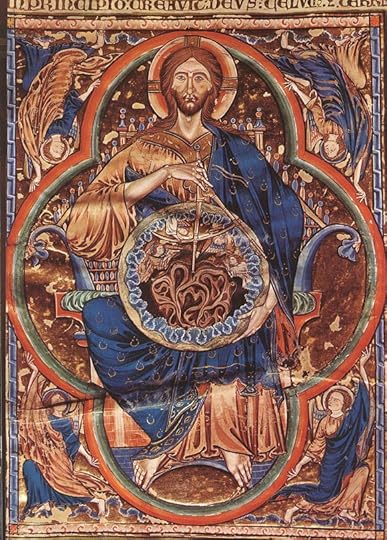
Man as Sub-Creator
J.R.R. Tolkien wrote,
“Man, Sub-creator, the refracted light
through whom is splintered from a single White
to many hues, and endlessly combined
in living shapes that move from mind to mind.
Though all the crannies of the world we filled
with Elves and Goblins, though we dared to build
Gods and their houses out of dark and light,
and sowed the seed of dragons, ’twas our right
(used or misused). The right has not decayed.
We make still by the law in which we’re made.”
(J.R.R. Tolkien, Tree and Leaf: Including the Poem Mythopoeia. Introd. by Christopher Tolkien (Boston, Houghton Mifflin, 1989), pp. 97-101.)
In Tolkien’s essay he was primarily speaking about world building, the act of creating worlds of fantasy and fairy tales that are different from our world but are at the same time related to the world we know and have their own internal consistency.
But we could argue that creating a consistent, secondary world extends far beyond the role of the writer of high fantasy. Any artist, whether they are a painter, singer, actor, writer, dancer, etc., creates a secondary world related to the world we know. In order for that secondary world to make sense it must have an internal consistency. And so the term sub-creator can be expanded upon to include any creative individual. A landscape designer or gardener is in effect creating a consistent, secondary world. Indeed all of our lives can be seen as works of art, and we are all sub-creators.
This is what pope saint John Paul II expressed in his 1994 “Letter to Artists .” “Not all are called to be artists in the specific sense of the term. Yet, as Genesis has it, all men and women are entrusted with the task of crafting their own life: in a certain sense, they are to make of it a work of art, a masterpiece.” (John Paul II, “Letter to Artists”)
Man is a creative being, he shares in the creative power of God. We cannot create as God does, that is, ex nihilo, out of nothing. But we can reshape the stuff of the world into new and wondrous forms, in imitation of the Creator of all things. In our creativity we mirror the created world, we accentuate the the mark the Creator has left on His creation, we highlight the spiritual relationship that still exists between God and man.
John Paul II made this distinction between the creative power of God and the sub-creative power of man. “The one who creates bestows being itself, he brings something out of nothing—ex nihilo sui et subiecti, as the Latin puts it—and this, in the strict sense, is a mode of operation which belongs to the Almighty alone. The craftsman, by contrast, uses something that already exists, to which he gives form and meaning. This is the mode of operation peculiar to man as made in the image of God.” (John Paul II, “Letter to Artists”)
In Greek the word for craftsman is “tektōn,” a word which is usually translated into English as “carpenter.” But “tektōn,” means so much more. In a broader sense, a “tektōn,” is an artificer, a “maker of things.” The word is not limited to the work of a carpenter but encompasses all craftsmen. The Gospel according to Mark, written originally in Greek, uses this word to describe Jesus, “Is not this the carpenter (“tektōn,”) the son of Mary…?” (Mark 6:3)
Jesus, in His divine nature, is the Creator, the Word through whom all things were made (John 1:3). In His human nature Jesus is sub-creator, a craftsman, a “maker of things.” Jesus, God and man, is an artist in every sense of the word.
Artist Vs. Craftsman
It is common in our contemporary society to compartmentalize every human endeavor. We We seem to take great delight in defining occupations ever more narrowly and then pitting them against each other; artist vs. craftsman, painter vs. illustrator, author vs. writer, and so on. But this is all vanity. We all share in the creative power of God, some of us, in addition, “make things.”
Man, then, draws wisdom and light from the Creator, and redirects it into new forms guided by his imagination. Though we have fallen from God’s grace we are redeemed through the sacrifice of Christ and still participate in God’s creative power, enjoying the right to imitate Creation.
this article originally appeared at www.DeaconLawrence.org
______________________________________
Pontifex University is an online university offering a Master’s Degree in Sacred Arts. For more information visit the website at www.pontifex.university
Lawrence Klimecki is a deacon in the Diocese of Sacramento. He is a public speaker, writer, and artist, reflecting on the intersection of art and faith and the spiritual “hero’s journey” that is part of every person’s life. He maintains a blog at www.DeaconLawrence.org
David Clayton's Blog
- David Clayton's profile
- 4 followers





